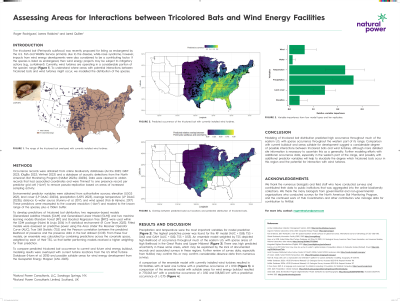Back

Multi-tech
Landscape-Scale Planning Opportunities and Challenges
Assessing Areas for Potential Interaction between Tricolored Bats and Wind Energy Facilities using Distribution Modeling
Tuesday, March 12, 2024
5:00 PM – 6:00 PM MT


Roger Rodriguez, MS
Bat Biologist/Principal Consultant
Natural Power, New York
Presenter(s)
Presentation Description: Probabilistic modeling methods, especially in the advent of machine learning use in ecology, are increasingly being employed to assess the predicted occurrence of species for biodiversity and individual species conservation and management. The tricolored bat (Perimyotis subflavus) was proposed for listing as endangered by the U.S. Fish and Wildlife Service primarily due to the disease, white-nose syndrome, however, impacts from wind energy developments were also considered to be a contributing factor. If the species is listed as endangered, then this will substantially expand the number of wind energy projects that occur within the range of an endangered bat species and result in increased mitigatory actions (i.e., curtailment) that will impact renewable energy production. To understand where areas with potential interactions between tricolored bats and wind turbines might occur, we modeled the distribution of the species using statistical and machine learning methods. The final ensemble model predicted high occurrence throughout much of the eastern U.S. with sparse occurrence throughout the western portion (central U.S.) of the species’ range. Comparisons with current buildout and areas suitable for development suggest a considerable degree of possible interactions between tricolored bats and wind turbines. These modeling methods can be beneficial in landscape-scale planning by increasing certainty in the potential occurrence of at-risk species. Additional data (species occurrence and/or environmental and ecological variables) may help to further increase certainty and elucidate the degree to which tricolored bats occur in a particular region and the potential for interaction with wind turbines.
